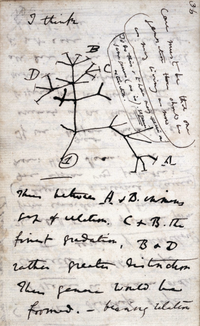
Photo from wikipedia
Gene expression in eukaryotic cells is a complex process encompassing several layers of regulation at the transcriptional and post-transcriptional levels. At the post-transcriptional level, microRNAs (miRs) are key regulatory molecules… Click to show full abstract
Gene expression in eukaryotic cells is a complex process encompassing several layers of regulation at the transcriptional and post-transcriptional levels. At the post-transcriptional level, microRNAs (miRs) are key regulatory molecules that function by binding directly to mRNAs. This generally leads to less efficient translation of the target mRNAs. More recently, an additional layer of gene regulation has been discovered, as other molecules, including circular RNAs (circRNAs), may bind to miRs and thereby function as sponges or decoys resulting in increased expression of the corresponding miR target genes. The circRNAs constitute a large class of mainly non-coding RNAs, which have been extensively studied in recent years, in particular in the cancer research field where many circRNAs have been proposed to function as miR sponges. Here, we briefly describe miR-mediated gene regulation and the extra layer of regulation that is imposed by the circRNAs. We describe techniques and methodologies that are commonly used to investigate potential miR sponging properties of circRNAs and discuss major pitfalls and controversies within this relatively new research field.
Journal Title: Essays in biochemistry
Year Published: 2021
Link to full text (if available)
Share on Social Media: Sign Up to like & get
recommendations!